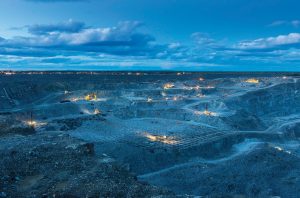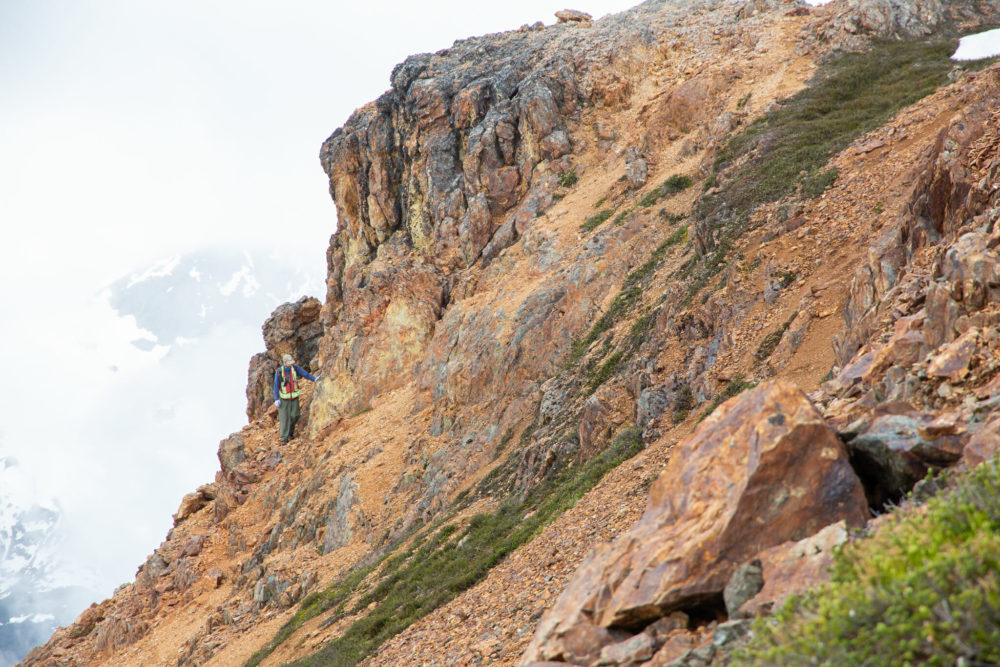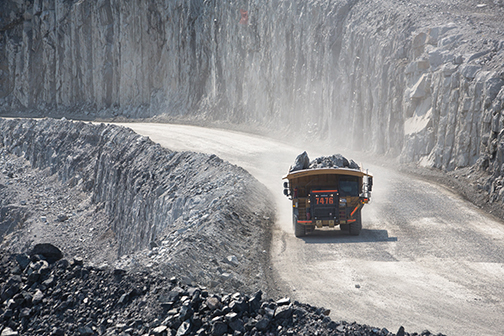Time to shine

The Canadian Malartic open pit gold mine in Quebec, owned by Agnico Eagle Mines and Yamana Gold. Credit: Agnico Eagle
As the price of gold reaches new record highs, investor interest in the operations and companies that actually mine the yellow metal is ramping up. In response, we’ve compiled a list of Canada’s top 10 producing gold mines, based on figures from 2019.
Between them, the mines on the list – which are limited to operations whose main commodity is gold – were responsible for more than 3.5 million oz. of gold production last year.
1. Canadian Malartic
Canada’s biggest gold mine, owned by Agnico Eagle Mines (50%) and Yamana Gold (50%) produced 669,192 oz. gold last year at cash costs of US$606 per oz. on a byproduct basis. (The mine also produced 833,754 oz. silver.)
Located in Malartic, Que., 25 km west of Val-d’Or, the mine began production in 2011. Agnico and Yamana acquired the 55,000 t/d open pit operation in 2014 through a $3.9-billion takeover of Osisko Mining.
With a mine life that currently extends to 2027, the partners are keen to keep a good thing going through exploration and have budgeted a total of $24 million this year for 107,000 metres of drilling.
They also began construction on the Odyssey underground ramp, expected to take two years, in August. Watch for an exploration update on Canadian Malartic Underground in the third quarter, followed by a preliminary economic assessment (PEA) next year.
Proven and probable reserves at Canadian Malartic stand at 133.8 million tonnes grading 1.11 g/t gold for 4.8 million oz.
2. Detour Lake
Kirkland Lake Gold’s $4.9-billion takeover of Detour Gold was finalized in late January, making the company the owner of Canada’s second-largest gold mine.
The Detour Lake open pit mine, located 300 km northeast of Timmins, Ont., produced 601,566 oz. of gold last year at a grade of 0.92 g/t gold.
This year, Kirkland Lake expects the mine to produce 520,000 to 540,000 oz. gold (taking effects of the COVID-19 pandemic into account) at cash operating costs of US$610-630 per oz.
The mine, which produced 1.8 million oz. of gold in the 1980s and ’90s, was put back into production in early 2013. It curently contains proven and probable reserves of 15.6 million oz. of gold in 498.4 million tonnes averaging 0.98 g/t gold, and a 22-year mine life.
Kirkland Lake has begun a 250,000-metre exploration program at Detour Lake, focused on updating and expanding reserves and the mine plan.
3. Brucejack
The only mine on our list to be owned by a single-asset producer, Pretium Resources’ Brucejack mine, 65 km north of Stewart, B.C., produced 354,405 oz. gold last year at cash costs of US$680 per oz. and an average grade of 8.7 g/t gold.
The high-grade, 3,800 t/d operation began commercial production in 2017.
With proven and probable reserves of 15.7 million tonnes averaging 8.4 g/t gold for 4.2 million oz. gold, the current mine life is 13 years.
Guidance for 2020 production has remained unchanged by the COVID-19 pandemic at 325,000-365,000 oz. of gold. However cash costs have been revised upwards to US$750-860 per oz. from US$725-830 per oz. of gold sold.
4. LaRonde
Agnico Eagle Mines’ flagship LaRonde mine, located mid-way between Rouyn-Noranda and Val-d’Or, Que., produced 343,154 oz. of gold last year at a cash operating cost of US$464 per oz. (on a byproduct basis).
The 7,000 t/d underground operation also produced 883,000 oz. silver, 13,161 tonnes zinc and 3,397 tonnes copper. Production at LaRonde began in 1988, and the mine became the deepest mine in North America in 2016, when operations reached over 3,000 metres depth.
As mining goes deeper, the risk of more frequent and larger seismic events increases. To reduce the risk to workers, Agnico has deployed an LTE communication network at the operation to facilitate the adoption of automated technologies.
LaRonde currently has a mine life of nine years, with proven and probable reserves of 14.9 million tonnes grading 6.02 g/t gold for 2.9 million oz. of gold.
5. Éléonore
From the time that Newmont became its official owner on Apr. 18, 2019, when its acquisition of Goldcorp closed, until the end of 2019, the Éléonore mine in the James Bay region of Quebec produced 246,000 oz. of gold. Newmont couldn’t provide CMJ production figures for the first quarter, so we don’t have an exact number for the full year. But based on their figures, and accounting for a more than one-month COVID-19-related suspension that began in late March, our best guess is that the mine produced around 328,000 oz. of gold last year.
In July, Newmont forecast 2020 production at the 7,000 t/d underground operation at 190,000 oz. of gold at cost of sales (CAS) of US$920 per oz. (That compares to pre-COVID-19 guidance of 355,000 oz. of gold at a CAS of US$760 per oz.)
Éléonore hosts proven and probable reserves of 8.3 million tonnes grading 4.84 g/t gold for 1.3 million oz. The mine achieved commercial production in 2015.
6. Porcupine
Newmont’s Porcupine operations consist of the Hollinger open pit, Hoyle Pond underground operations, and a mill in Timmins, Ont., as well as the Borden underground mine near Chapleau, which reached commercial production last fall.
Like Éléonore, Porcupine was added to Newmont’s portfolio with the acquisition of Goldcorp, so we don’t have an exact production figure. The operation produced 223,000 oz. gold from Apr. 18 to the end of 2019, and unlike Éléonore, mine operations have not been significantly interrupted by the COVID-19 pandemic, so we estimate 2019 production at approximately 309,000 oz. of gold.
For 2020, Newmont forecast in July that Porcupine would produce 325,000 oz. of gold at CAS of US$795 per oz.
Combined open pit and underground proven and probable reserves at Porcupine total 54.3 million tonnes grading 1.63 g/t gold for 2.8 million oz. of gold.
7. Rainy River
New Gold’s Rainy River mine, located 65 km northwest of Fort Frances, Ont., produced 253,772 oz. gold and 282,053 oz. of silver last year. On a gold-equivalent basis, production was 257,000 oz. at total cash costs of US$910 per gold-equivalent oz.
In February, the company released a new mine plan to lower costs and deliver free cash flow beginning in the fourth quarter. The plan reduces the mine life by three years to end in 2028 and cuts reserves by 1.5 million oz. gold, but boosts profitability based on a US$1,275 per oz. reserve price.
The mine is now forecast to produce an average of 289,000 oz. of gold per year at cash costs of US$665 per oz.
Proven and probable reserves (open pit and underground) now stand at 77.6 million tonnes averaging 1.06 g/t gold and 2.5 g/t silver for a total of 2.6 million oz. gold and 6.3 million oz. silver.
Commercial production at Rainy River began in October 2017.
8. Macassa
Kirkland Lake Gold’s Macassa mine poured 241,297 oz. of gold in 2019 at operating cash costs of US$414 per oz.
Located in Kirkland Lake, Ont., the historic underground mine is one of the highest grade gold mines in the world.
Kirkland Lake began sinking a new shaft at Macassa with a 4,000 t/d hoisting capacity in 2018. The #4 Shaft, which will eventually allow the company to increase production to 400,000 oz. of gold annually, will be completed in two phases. The first phase, down to 5,450 ft., is expected to be complete in the second quarter of 2022 at a cost of $240 million. A second phase with an ultimate depth of 7,000 ft. and at a cost of $80 million, should be complete by the end of 2023.
The current mine life at Macassa is nine years, with proven and probable reserves pegged at 3.9 million tonnes grading 21.9 g/t gold for 2.3 million oz. The mill currently has a capacity of 2,200 t/d.
9. Hemlo
Barrick’s Hemlo mine, located about 35 km east of Marathon, Ont., produced 213,000 oz. gold last year at total cash costs US$904 per oz.
The company projects 2020 production will be in the same range – between 200,000 and 220,000 oz. of gold – but at a lower cash cost of US$800-850 per oz.
Hemlo, an open pit and underground operation with a 10,000 t/d mill, has produced more than 21 million oz. of gold over more than three decades of continuous operations.
Proven and probable reserves currently total 1.3 million oz., with proven reserves of 910,000 tonnes grading 4.94 g/t gold and probable reserves of 9.7 million tonnes grading 3.82 g/t gold.
10. Meliadine
The last mine on our list is also the newest operation, with commercial production beginning in May 2019. Agnico Eagle Mines’ Meliadine mine, 25 km north of Rankin Inlet in Nunavut, produced 191,113 oz. of gold in 2019 at cash costs of US$748 per oz.
The mine, which had been forecast to produce 350,000 oz. gold this year before the pandemic hit, saw reduced mining activities between late March and early June due to COVID-19.
Mining activities returned to normal levels in June, with a mill expansion to 4,600 t/d from 3,750 t/d scheduled to be completed by the fourth quarter. For the first six months of the year, Meliadine produced 129,350 oz. of gold at total cash costs of US$915 per oz.
The underground and open pit operation has a mine life of 12 years, with proven and probable reserves (open pit and underground) of 20.7 million tonnes at an average grade of 6.1 g/t gold for 4 million oz.





Comments
andrew croal
I am a Mining Engineer, and part-time poet. When I saw that Berkshire H had bought into ABX, I wrote the following. Enjoy…..
BRK buys ABX
Who predicted, who foresaw
the Oracle of Omaha
could bless a relic so barbaric,
dump his banks, go long on Barrick?
Half a billion – with a ‘b’
buys a little equity.
Now, one percent is not a lot.
It’s puzzling that he just forgot
the snarky comments made on gold,
(that bygone pet rock bugs would hold).
Is this case of ‘grasp the nettle’
endorsement of the yellow metal?
The substance mocked so many years,
unsuited both to greed and fears;
Useless gold – no dividend.
Now our newly minted friend
Of King and Bay Streets and of mining
envisages some golden lining.
It seems a most peculiar play –
a bet against the USA?
I wonder what has changed his views.
Maybe risks and revenues.
‘Buy low, sell high’ is valid, true.
A snap to say but hard to do.
Where’s the gain and what’s the yield?
What wisdom’s soon to be revealed?
We hasten on engulfed in debt,
and Covid’s far from over yet.
The market’s never wrong, they say.
The masks in time will fade away.
We will get through this smarter, stronger.
The debt may cling and linger longer.
Meanwhile, money presses spin.
Perhaps he felt he’d best get in.
I.B. Kidding Aug 2020